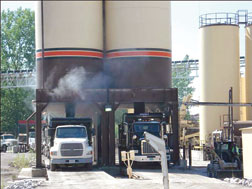 Astec Industries Inc. Last month's demonstration is under review. |
Engineers at a Chattanooga, Tenn.-based manufacturer have made asphalt and its foul fumes go together like oil and water. Their method? Injecting water into hot liquid asphalt produces a foaming binder that cuts down on natural resources and keeps drivers from rushing to roll up their windows.
European additives that produce "warm-mix" asphalt were the inspiration for the water-injection method developed by Astec Industries Inc. Its executives wanted to find a way to make asphalt easy to lay at lower temperatures without introducing expensive chemicals, which can increase mix costs by several dollars per ton.
 |
| Brock |
"I went a couple of years ago and bought two cans of shaving cream and painted them black," says J. Don Brock, Astec's chairman and chief executive. "I put them on my chief engineer's desk and said, 'Make me a foam that looks like this stuff.'"
What resulted is a rich-looking asphalt that makes the material more workable at 270°F, at least 50° cooler than conventional hot mixes. Compaction equipment removes the bubbles, and the binder stiffens. The new method could save asphalt operators 11% on rock-heating costs while eliminating asphalt emissions, Brock says. Combining the method with reclaimed asphalt pavement (RAP) could significantly reduce installation costs as well.
 Astec Industries Inc Warm mix (right) isn't smoky. |
Three weeks ago, a local Chattanooga road builder paved a thoroughfare there using the "green" asphalt method combined with 50% RAP. The 3,400-ton mix was spread out across 1.4 miles of a three-lane frontage road.
"It turned out great," says Scott Thompson, vice president of Rossville, Ga.-based Talley Construction Co. and Southeastern Materials Inc. The contractor made the mix from an existing Astec plant fitted with the company's bolt-on injector. "It allows us to produce the mix with no smoke, no smell," says Thompson.
The mix clearly improved emissions (see photo). But its long-term savings are yet to be seen. Last month's demonstration project saved the owner about 25% mostly due to milling and recycling. The injector retrofit costs between $35,000 and $40,000.
"We don't have enough working knowledge to know how much savings there is," Thompson says.
Using RAP promises a net savings, but it requires special crushing and screening, and virgin rock has to be heated hotter than usual to facilitate binding. Still, "It's going to take a lot to outweigh $300 liquid and $8 rock [per ton for virgin material]", says Thompson.
"The big win on this in my opinion is the ability to run higher amounts of recycle without changing the grade of the asphalt," notes Brock. Foaming the binder increases its surface area, helping it to cover new and used aggregate at lower temperatures.
Warm-mix asphalt produced with the water-injection method may be workable at even lower temperatures. But there are limitations. "When you get down below 212�, the game's over," Brock says.
Scientists studying samples at Auburn, Ala.-based National Center for Asphalt Technology are optimistic. "The method works," says E. Ray Brown, NCAT director. Test results, which scientists plan to reveal this month, will show how the mix performs under traffic and rain.
Foaming asphalt is not a new process. Traditionally, it is done in the field for "cold" in-situ recycling on low-traffic roads. If the new warm-mix method holds up, it could tip the scale toward recycling more on well-traveled roads, such as Interstates. Foaming at the plant offers more control over the mix, potentially improving its long-term durability.
"If it is not acceptable, we think we can modify the process to make it acceptable," Brown says. Highway owners have been conservative on recycling due to questions over performance. But cost inflation has recycling on the rise, and several studies are under way to evaluate higher percentages of RAP.
Building long-lasting, recycled roads has been a research priority for the asphalt industry just about as long as it has been under fire to reduce irritating emissions.
Achieving both is "kind of like the double punch," Thompson says.



Post a comment to this article
Report Abusive Comment